COMMENT OF THE DAY: INVENTING THE HEIGHTS TEARDOWN “Correction– The tearing down of old homes to build new was pioneered by Sterling Victorian Homes in the mid-late 1980s. It began on the 400 block of 22nd Street. These homes look very modest by today’s standards. It is likely true that Allegro pioneered the building of Disney-fied Hummer homes with cheese closets…” [Sheila, commenting on Scaling Back the Upscale: Allegro Builders, Downtempo]
Tag: Houston History
THE ASTRODOME AND THE COLOSSEUM Ken Hoffman returns from Italy with a little perspective: “The Colosseum was originally called Amphitheatrum Flavium, and it was built by the powerful emperors Vespasian, Titus and Domitian. The Astrodome was originally called the Harris County Domed Stadium, and it was governed by former Houston Mayor and Harris County Judge Roy Hofheinz. He just thought he was an emperor. The Colosseum, after several expansions (mostly to honor a new emperor), had a seating capacity of about 65,000. It had 80 entrances and could completely fill and empty in less than five minutes. The Astrodome, after several expansions (mostly to stop Houston Oilers owner Bud Adams’ whining), had a seating capacity of 62,000 for football. It would take an hour to get out of the parking lot because of a lack of exits. Parking was cheaper in ancient times, too.” [Houston Chronicle; previously in Swamplot]
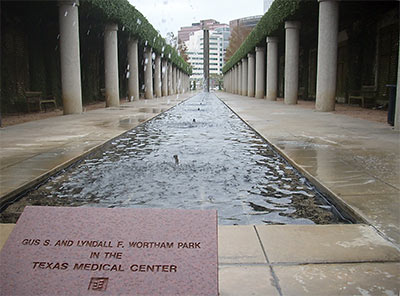
As a prelude to the extended narrative of his and John Nova Lomax’s latest grand pedestrian effort — a 14-hour walk from IAH to Downtown — Marfa city councilmember and Houston bingo scofflaw David Beebe describes his first encounter with the Gus and Lyndall Wortham Park at the southwest corner of Holcombe and Main. It’s the walkway and fountain assembly that replaced the Shamrock Hotel:
On this day, as on many days, the fountain is actively spouting water columns to nobody, as the fountain downtown on the light rail line is supposed to do (but is always messed up). This bizarre guilt trip tribute to the concept of public space mixes elements of a grand promenade with Vegas style accents contrasting with the feel of a confined and secluded corridor. Its out of the way entrance and low visibility from Holcombe is probably why I had never seen it before. This is a very good park to go to if you don’t want anyone to find you. I couldn’t help but picture Nixon and Kissinger walking side by side alongside the fountain and columns planning the next offensive maneuver in Vietnam.
- Beyond Bush IAH to North Main- the longest walk [David Beebe’s take on music and more in Texas]
- Previously in Swamplot: Snuff Is Not Enough: South Post Oak Lubricated Walking Tour, A Walk Down Cheezy Street: Richmond Avenue, Past Its Prime, Southeast Side: A Tour of the Houston Heartland, Long Point, Long Walk, Long Story, Telephone Road Walking Tour: Not How They Sang It Was, Shade, Subs, Plexes and Suds: A Bissonnet Story, Lonely East Side Walking Tour, Walking on Bellaire
Photo: David W. Beebe
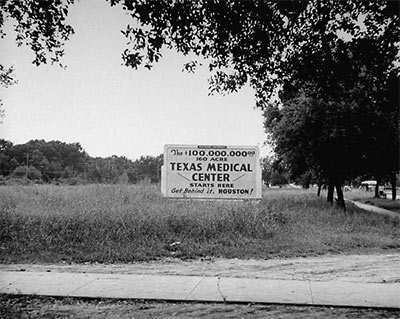
This 1946 Dmitri Kessel photo of some not-long-vacant Houston property is just one of a half-million images from the Life magazine photo archives that are now only a Google search away. Google is announcing that the entire collection of photos taken for Life magazine — about 10 million in all — will be available within the next few months. About 97 percent of these images have never been seen by the general public.
The images are available from a simple Google image search. You can single out the Life images by adding “source:life” to your search or by starting at this gateway.
Houston photophile Robert Kimberly, who’s been poring through the collection, says
There are loads of Houston pictures, but add “TX” or Texas” to narrow a search to the city. Otherwise you’ll be seeing lots of “Whitney.”
- LIFE Photo Archive available on Google Image Search [Google Blog]
- Google Hosting Time-Life Photo Archive, 10 Million Unpublished Images Now Live [Search Engine Land]
- Houston in Life Magazine: Online Photos Thanks to Google [Neon Poisoning]
Photo of sign advertising opening of Texas Medical Center, 1946: Dmitri Kessel, Life Magazine
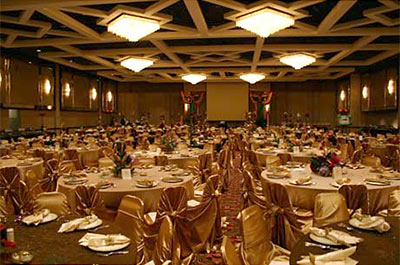
The last remaining building associated with Houston’s 1950s-era glam-magnet Shamrock Hotel is slated to be torn down, reports Cynthia Lescalleet in the West U. Examiner. The Shamrock’s former ballroom facility at 2151 W. Holcombe became the Edwin Hornberger Conference Center in 1996, nine years after the Shamrock itself was famously axed.
The Texas Medical Center has more building plans for the site:
TMC will build 250,000 square feet of office space in three floors to be added atop the Bell building, which also houses the existing parking garage, said TMC’s John Kajander. The added space is to support TMC institutions, he said.
The building housing the Hornberger’s foyer and ballroom “is nearing the end of its useful life,†he said, and will be taken down.
A little Hornberger history:
One more reason to get excited about the possibility of another Depression: It could save the Jim West Mansion in Clear Lake!
Two years ago, a real-estate company controlled by former Houston Rocket Hakeem Olajuwon bought the mansion with plans to subdivide its 41 acres for sale to developers. At one point, the mansion seemed about to be razed. At another, it seemed likely to become the centerpiece of a luxury complex for retirees.
But as of yet, no deal has solidified. And that’s where [Clear Lake schoolteacher Linda] Sansing finds a strange upside to talk of a new Depression: With credit tight, it seems unlikely that a for-profit developer will swoop in.
Great! But . . . will that make raising money for preservationists to buy the property any easier?
Linda Sansing’s nonprofit group, Preserved in Time, aims to raise $100,000 in earnest money, so it can make an offer on the mansion and some of its grounds. She figures that, ultimately, the group will need $11 million to buy the mansion and some of its land. Some of that money could come from opening the mansion to the pubic for rentals and tours. Some could come from grants. But she knows she has a long way to go.
- Preservationists hope to rescue West mansion [Houston Chronicle]
- How the West won [Houston Chronicle]
- Saving the Jim West Mansion [Houston Public Radio]
- Jim West Mansion Photo Story [Preserved in Time]
Video: Preserved in Time
THE FINANCIAL CRISIS: KINDA LIKE FLOODING IN MEYERLAND A rising tide sinks all prices! “When Dr. Mahmoud Amin El-Gamal, chairman of the Rice economics department, is asked — as he has often been in recent days — ‘What’s is going on with our financial institutions?’ he likes to begin his answer with an analogy of local origin. ‘It’s a lot like in the 1980s when the flooding in Meyerland caused the price of all the houses in the area to go down,’ he said, ‘even those houses that did not flood.’ El-Gamal said the same can be said of mortgage securities, many of which were ‘perfectly fine,’ but had been grouped with debts that would likely continue to go unpaid.” [West University Examiner]
GALVESTON AFTER THE SECOND GREAT HURRICANE
“My sense is that Galveston will come back as a weekender community and a modest tourist vista, but that commerce not related to the tourism industry will continue to decline at an accelerated rate. My sense is that what we might see in 20 years is a community comprised of a few high-rise condos and resorts along the seawall, the ubiquitous weekender homes on the West Beach and not much else. It will certainly be easier to evacuate such a community.” [Houston’s Clear Thinkers]
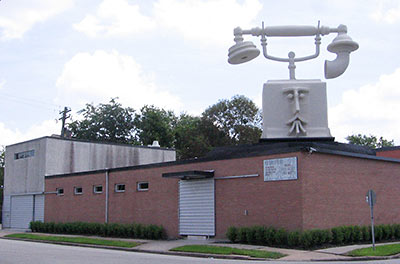
Having once graced a hotel owned by a legendary real-estate swindler, David Adickes’s telephone sculpture has quite the Houston pedigree:
Adickes first placed it on a friend’s property off SH 4 and FM 1960 before leasing to J.R. McConnell, former owner of the Grand Hotel, now called The Derek, on the corner of Westheimer Road and the West Loop.
“I said that I am going to make you a deal you cannot resist,†recalled Adickes of their arrangement. McConnell leased it for a penny a day and gave the artist $36.50. “He actually paid 10 years in advance,†Adickes said, laughing at the memory.
“Big Alex†was forced to move from that location, though, when The Grand Hotel became the Derek. It lived on Adickes’ personal lot on the corner of I-45 and Quitman Street for about six months. During that time, Adickes was forced into a back and forth battle with someone who felt the face on the phone needed its mustache painted black.
Robert Kimberly finds Big Alex in its new home at the corner of Mason and Hyde Park in Montrose, on top of Pictures Plus Prints and Framing. (Yeah, you read it here first.)
- Wednesday Night Photo Post: “Big Alex” by David Adickes [Neon Poisoning]
- ‘Big Alex’ making big smiles in Montrose (Google cache) [River Oaks Examiner, via Neon Poisoning]
- McConnell, five others named in bank fraud case [Houston Chronicle]
- McConnell first lost control, then hope [Houston Chronicle]
- A Big Telephone Tip [Swamplot]
Photo: Robert Kimberly
BOOMTOWN HOUSTON IS BACK, THOUGH MAYBE A LITTLE DUSTY “Boomtown is a strategy game simple in concept but surprisingly difficult to master. The board features several groups of properties – Rice, Montrose, River Oaks, Downtown, Bellaire, West U. and others. Four people can play, as characters Billy Bob, Fast Eddie, Aunt Hattie and Day Bue, charmingly drawn in old-fashioned style by Merriman. Each player starts out with a certain amount of money and bids against the others, trying to build real estate empires.” [Hair Balls, via Swamplot Inbox]
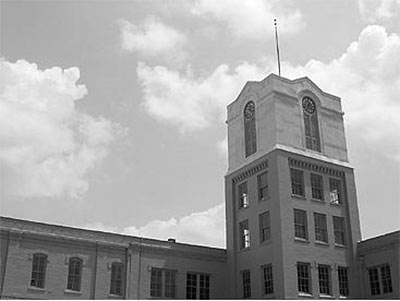
On June 1st, Scott Tycer will be opening a new wholesale and retail location of his Kraftsmen Bakery in 10,000 long-vacant square feet of the old Oriental Textile Mill on 22nd St. and Lawrence in the Heights. Also opening in the space two months later: a 1,200-square-foot restaurant with a garden patio and bar area, designed by Ferenc Dreef.
Tycer, who was the chef at Aries and then Pic on Montrose, and who runs Gravitas on Taft (which Dreef also designed), will be cooking at the restaurant, which will be called Textile. Tycer described Textile to blogger Cleverley Stone:
We’re going to build out the dining room with textiles, lots of hanging fabrics and different tablecloths on each table. This will not be your typical white-tablecloth restaurant.
Tycer is right: White tablecloths would probably not be appropriate for the space. A history of the Heights written by Sister M. Agatha of the Incarnate Word Academy and published in 1956 describes the operations of the textile mill, which was originally built in 1892 as a mattress factory:
B. J. Platt for years was superintendent of the plant that turned out a product which looked like long rolls of carpeting and which was used for pressing cotton seed oil. The plant’s capacity was about 50 rolls a day, varying in price from $200 to $400 a roll.
The textile was woven from hair. Old residents of the Heights have handed down the story that in the beginning much of the hair was obtained from China when pigtails were being discarded. But certain it is that camel’s hair in time came to be the staple used in production.
- Old Heights textile mill perfect spot for bread wholesaler [Houston Chronicle]
- Scott Tycer Weaves Together Past, Present & Future with New Restaurant [Cleverley’s Blog]
- Chapter I: The Development of a Suburban Addition [The History of Houston Heights, 1891-1918]
- more details on textile [Tasty Bits]
Photo of Oriental Textile Mill: Tasty Bits
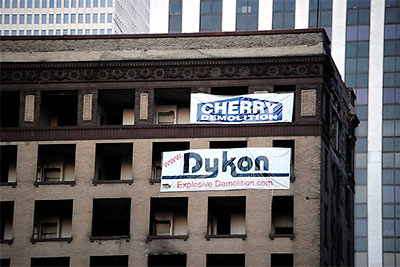
Reluctant rubble maker Cherry Demolition was once exclusively a house-moving company, shuffling quaint little homes in West University. But that was before the late 1980s, when the neighborhood started changing, reports the Houston Business Journal:
Older bungalow-style houses were being torn down and replaced with new multiple-story brick homes.
Instead of watching potential moving business disappear along with the bungalow homes, the Cherry brothers drew up a plan to buy the bungalow-style houses, remove them from the property, find a buyer with a vacant lot, sell the house and then deliver it.
But although this strategy kept the house-moving business going, it was not without problems.
Houses that were too wide, roofs that were too tall or termite damage increased the cost of moving a structure. Three strikes against a house usually meant passing it over. Usually only one in about 20 houses was a suitable candidate for moving and reselling.
Hmmm . . . what to do???
Then inspiration struck. If only one out of 20 homes could be moved, the rest were candidates for demolition, the brothers realized.
- Movers and shakers [Houston Business Journal]
- The Downtown Boom: Reader Photos and Videos from the Montagu Hotel Implosion [Swamplot]
Photo of Montagu Hotel by Flickr user ss.yesterday
 David Kaplan of the Chronicle catches up with Houston-apartment legend Michael Pollack and fills in a few details of the Colonial House story:
David Kaplan of the Chronicle catches up with Houston-apartment legend Michael Pollack and fills in a few details of the Colonial House story:
According to media reports then, Pollack lived in a super-size Colonial House apartment called “the Dream Suite,” which had a colored water fountain inside and a king-size water bed.
The Dream Suite was real, but Pollack says he never lived there. His home was the Four Leaf Towers and later the Houstonian, he said.
His glamorous stud image was just an act, he maintains, designed to rent apartments.
“I was promoting day and night,” Pollack said. “To me, it was a job.” . . .
According to Houston City magazine, he’d show up at nightclubs in a chauffeured custom Cadillac limousine with a moon roof. He traveled with an entourage, including bodyguards in satin jackets adorned with Pollack’s silhouette.
There are more memorable Pollack TV spots to be dug up:
One commercial featured Pollack in a safari outfit and a tiger. He had a fear of cats, even little cats, and being next to the full-grown beast was terrifying, he recalled.
In 1986, Pollack left Houston because, he said, the local economy and apartment market looked increasingly grim.
Colonial House was foreclosed on in 1988. It was acquired by DRG Funding Corp., the lender that financed the complex’s redevelopment. Pollack moved back to California, working there a few years before settling in Mesa[, Arizona].
In Houston, the Colonial House era is no more. A year after the foreclosure, the mammoth complex changed its name to Lantern Village.
After the jump: Laundry tips from a longtime resident of today’s Lantern Village!
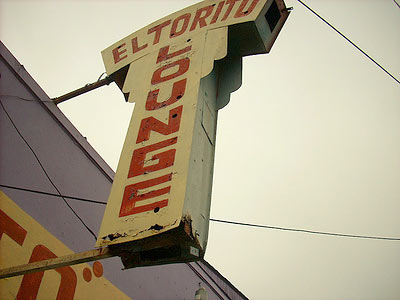
Houston’s lone professional tourists, John Nova Lomax and David Beebe, stop off at the Brady’s Island in the Ship Channel midway into their latest day-long stroll . . . through this city’s southeastern stretches:
The air is foul here, and the eastern view is little more than a forest of tall crackers and satanic fume-belching smokestacks, sending clouds of roasted-cabbage-smelling incense skyward to Mammon, all bisected by the amazingly tall East Loop Ship Channel Bridge, its pillars standing in the toxic bilge where Brays Bayou dumps its effluent into the great pot of greenish-brown petro-gumbo.
While Brady’s Landing today seems to survive as a function room – a sort of Rainbow Lodge for the Ship Channel, with manicured grounds that reminded Beebe of Astroworld — decades ago, people came here to eat and to take in the view. This was progress to them, this horrifically awesome vista showed how we beat the Nazis and Japanese and how we were gonna stave off them godless Commies. As for me, it made me think of Beebe’s maxim: “Chicken and gasoline don’t mix.â€
More from the duo’s march through “Deep Harrisburg”: Flag-waving Gulf Freeway auto dealerships, an early-morning ice house near the Almeda Mall, a razorwire-fenced artist compound in Garden Villas, Harold Farb’s last stand, colorful Broadway muffler joints, the hidden gardens of Thai Xuan, and — yes, gas-station chicken.
“There is nothing else like the Southeast side,” Lomax adds in a comment:
I see it as the true heart of Houston. Without the port and the refineries we are nothing. The prosperous West Side could be Anywhere, USA, but the Southeast Side could only be here.
- Sole of Houston: Deep Harrisburg: Lomax and Beebe Take on the East Side Again [Houstoned]
- Brady’s Landing
- Previously in Swamplot: Long Point, Long Walk, Long Story, Telephone Road Walking Tour: Not How They Sang It Was, Shade, Subs, Plexes and Suds: A Bissonnet Story, Lonely East Side Walking Tour, Walking on Bellaire
Photo of El Torito Lounge on Harrisburg: John Nova Lomax and David Beebe
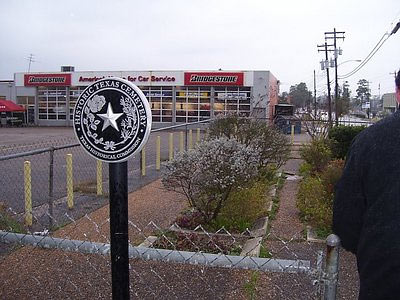
There’s just too much to take in from the latest rambling, illustrated walking tour by David Beebe and John Nova Lomax, narrated in harmony from their two separate corners of the Texan blogosphere. The pair’s latest venture — appropriately enough — runs along Long Point, through the heart of Spring Branch:
. . . primarily Long Point is a binary street combining Mexico and Korea. In contrast to the multi-ethnic riot that is Bissonnet, or the Pan-Asian explosion that is Bellaire, Long Point is binary. Some businesses fuse into MexiKorea. The Koryo Bakery, right next door to the only Korean bookstore in Houston, touts its pan dulce y pastels, for example, and it seems that many of the Korean-owned businesses aim at Spanish-speakers more than Anglos. (Someone should open a restaurant out here called Jose Cho’s TaKorea.)
The camera-and-tequila-toting duo guide us through a shady thrift-store nirvana they declare to be drab but safe, pointing out salient features along the way: cans of silkworm pupae in a former Kroger turned Korean supermarket, and the historic Hillendahl Cemetery (pictured above) carved out of one corner of a Bridgestone tire barn parking lot.
After the jump, more Spring Branch walking-tour highlights!

